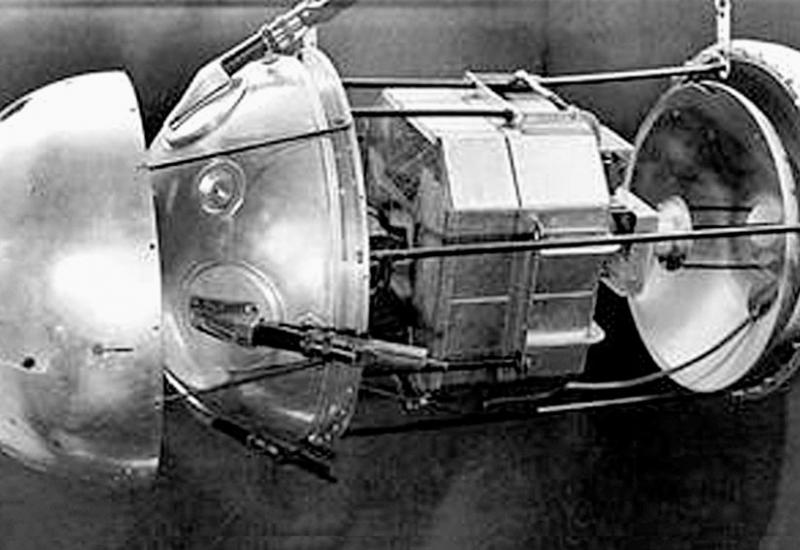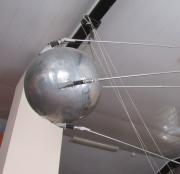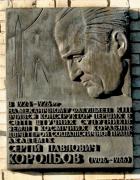The international Astronautical Federation announced on 4 October 1957 The day of beginning space era of humanity. In this day in 1957 in the Soviet Union on the earth orbit was launched the world's first artificial Earth satellite. In Kyiv Polytechnic, he is depicted on a memorial plaque, which is installed on the front of the first building and dedicated to a former student of KPI S. P. Korolev – the Chief designer of rocket technology, leader in the development of spacecraft, the initiator of creation of the satellite. A model of the first artificial satellite of the Earth can be seen in Department of History of Aviation and Astronautics of the State Polytechnic Museum under the KPI named after Igor Sikorsky.
On May 13, 1946, the government of the Soviet Union adopted a resolution establishing a missile industry and science in the USSR. On the basis of artillery factory No. 88 was established state Scientific research Institute SRI-88. In this research institute, the USSR Ministery of Defense was appointed Sergei Pavlovich Korolev as chief designer of long-range ballistic missiles. In June 1946, the construction of a test rocket area, Kapustin Yar, was began, where lieutenant general Vasily Ivanovich Voznyuk was appointed head.
At the Kapustin Yar landfill, on October 10, 1948 was the first launch of a one-stage ballistic missile R-1 developed by S.P Korolev, and it was subsequently tested for missiles R-2, R-5. In the context of the cold war, the Soviet leadership set the task to create a missile that can reach the territory of the United States. Rocket R-5 had a range of 1200 km, and it was unusable. At the same time with the participation of the USSR Academy of Sciences was started a program of geophysical launches to study the state of the atmosphere at high altitudes. On 22 July 1951 from the Kapustin Yar for the first time was launched rocket R-1B with an experimental animals – dogs Dezik and Zigan. In pilot launches, hermetic booms, high-rise spacesuits, catapults, parachute rescue systems were tested and refined, active sensing of the upper atmosphere and ionosphere was carried out, as well as experiments on the propagation of radio waves.
In newspapers and popular scientific journals increasingly appeared a publication devoted to space projects. Among their authors were "discovered" Soviet (A. A. Sternfeld, G. I. Pokrovskiy, Y. S. Khlebtsevich, F. Y. Zigel, etc.) and foreign (W. von Braun, V. Lei, E. Burces, K. Gtland, etc.) professionals.
On may 20, 1954 issued a decree of the USSR government to develop, under the leadership of S. P. Korolev a two-stage Intercontinental missile R-7. The colleague S.P.Korolov, Mikhail Klavdievich Tikhonravov, who worked at the Defense Ministry's Research Institute-4, came to the idea that such a missile could become a carrier of not only combat thermonuclear charge, but also an artificial earth satellite. He formalized this idea in the form of engineering notes.
Receiving the notes Tikhonravov, S.P. Korolev acted decisively. On May 27, 1954, he submitted to D.S. Ustinov the Minister of Defense of the USSR the memorandum on the possibility and expediency of launching an orbital satellite on the base of the P-7 missile. On the creation of the satellite together with S. P. Korolev worked scientists: N. In.Keldysh, N. With.Lidorenko, G. Yu Maksimov, V. I. Lapko, A. V. Bukhtiyarov, etc.
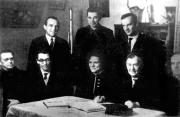 Success in the creation of a two-stage Intercontinental missile R-7 was facilitated by a large research group M.K. Tihonravov (G. Yu. Maximov, G. N. Chernyshov, I. M. Yatsunsky, etc.). The group has developed a large program of space exploration: the launch of the first satellite, the creation of manned spacecraft and stations, landing on the moon. They did a great design job by overcoming many difficulties. So in the creative searches was born the world's first Intercontinental rocket, which was destined to become a masterpiece of engineering.
Success in the creation of a two-stage Intercontinental missile R-7 was facilitated by a large research group M.K. Tihonravov (G. Yu. Maximov, G. N. Chernyshov, I. M. Yatsunsky, etc.). The group has developed a large program of space exploration: the launch of the first satellite, the creation of manned spacecraft and stations, landing on the moon. They did a great design job by overcoming many difficulties. So in the creative searches was born the world's first Intercontinental rocket, which was destined to become a masterpiece of engineering.
Kapustin Yar did not meet the requirements for the placement of new objects due to the limited territory, a large population of the surrounding area, a major industrial center of Stalingrad. In addition, one of the radio control points would have to be placed in the Caspian Sea.
In February 1955 The Council of Ministers of the USSR adopted the Resolution "On a New Testing Ground for the USSR Ministry of Defense".
The degree of importance of the choice of location for landfill told the Commission: Deputy Chairman of the Council of Ministers V.O.Malyshev, deputy defense ministers Marshal G.K.Zhukov and O.M.Vasilevsky, Minister of Radio Industry V.D.Kalmykov. To the place for the new landfill are very strict requirements: the track of a missile should not be less than 8000 km, it should be located on the territory of the Soviet Union and have two fields fall for the first stage separated, and the head part (MS). Near the route should not be large settlements in case of emergencies. The alienation of land for construction of the landfill should not cause significant damage to the national economy. Reconnaissance group for the choice of the future site was headed by Lieutenant-General V.I. Voznyuk. And this place was chosen in Kazakhstan, near the Tire-Tam ride. Need to say that officially at that time it was not talking about launching the satellite. A polygon was created to test military Intercontinental missile R-7 with a range of 8,000 km.
The advantages of the place for the placement of the new landfill were: the presence of the railway line Moscow – Tashkent, the presence of a large Syrdarya river and the preservation of works that were carried out here.
However, the emptiness of the area was simultaneously a disadvantage due to the lack of housing, energy sources, road network, communications and other achievements of civilization. In addition, there was a sharply continental climate, from minus 30°C with winds in the winter and up to +50°C without wind in summer. In addition, the district was one of three world centers of epidemics of plague and cholera.
And in this place it was necessary to build a unique structure, to find and test the appropriate thermal protection materials for preserving the integrity of the MS when entering the dense layers of the atmosphere, to create a new radio system and control the flight path, to build the control and measuring complex (ERC), which involves the observation of a missile and receive telemetry information from the starting point to the Pacific ocean.
In February 1955 on the station arrived the first group of builders, headed by the senior lieutenant I.M.Deinezhkin and immediately proceeded to geodetic works. In the short term was built starting and technical positions, two points of radio, nine measuring points (OP) in the area of fall of the first stage and six in the region of the head part of the rocket (in Kamchatka), a radio transmitting and receiving centres, lines of communication (governmental, distant), roads, Railways, water, high voltage and telephone line to start to the integration building (MIK). In addition, it was built three residential town in the starting area, one on the Kamchatka and 12 on the measuring points.
The first commander of the training ground was Lieutenant-General O.I. Nesterenko, the first head of the landfill construction, Major-General G. M. Shubnikov.
15 may 1957 from the training ground of Baikonur launched the first rocket R-7, but failed. Was unsuccessful, and two more launches – June 11 and July 12. Good was the fourth launch on 21 August, when the main part has reached the area of the fall – Kamchatka.
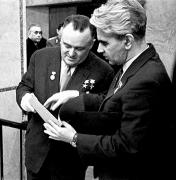 Working on the creation of an Intercontinental missile R-7, S.P. Korolev kept coming back to the idea of practical space exploration. March 16, 1954 at the meeting with the academician M.V. Keldysh was identified a range of scientific problems, which can be solved with the help of satellites. And in August 1954 The Council of Ministers of the USSR approved the proposals on the elaboration of scientific and theoretical issues related to space flight.
Working on the creation of an Intercontinental missile R-7, S.P. Korolev kept coming back to the idea of practical space exploration. March 16, 1954 at the meeting with the academician M.V. Keldysh was identified a range of scientific problems, which can be solved with the help of satellites. And in August 1954 The Council of Ministers of the USSR approved the proposals on the elaboration of scientific and theoretical issues related to space flight.
30 Jan 1956 The Government of the USSR adopted a resolution that foresaw the creation in 1957-1958 of an unoriented satellite of the Earth. General management and provision of equipment for research was entrusted to the Academy of Sciences of the USSR; the creation of a satellite – in the Ministry of Defense Industry (Prime contractor OKB-1); development of a complex radio system, electronic equipment and telemetry systems to the Ministry of radio industry; creation of gyroscopic instruments to the Ministry of the shipbuilding industry; development of a complex ground-launchers, filling and conveying equipment for the Department of mechanical engineering, conducting pad – the Ministry of Defence.
In 1956 M. K. Tihonravova was transferred from NII-4 of the Ministry of Defence in OKB-1 to S. P.Korolev to the post of head of Department of design of various satellites (including the first), manned spacecraft, spacecraft to study the moon and some planets of the Solar system.
Since 1 may 1958, took place the international geophysical year. 67 countries have conducted a joint geophysical investigation and observation. And the United States said that in 1958 they launch into space their own satellite. It was a matter of prestige.
February 15, 1957, adopted a resolution on the withdrawal in the space of the simplest unoriented Earth satellite. Development of the conceptual design of the satellite has instructed the design Department, led by S. S. Kryukov, a research assistant was M.K. Tikhonravov. On the draft design worked employees of sector E. F. Ryazanov I. V. Lavrov, V. V. Molodtsov, V. I. Petrov, N. P.The Kutyrkin, A. M. Sidorov, L. M., Soldatova, N. With.Florina, N. P.Belousov, V. V. Noskov and others.
Although the satellite was called the simplest, but it was created for the first time, no analogues in the technique was not. The condition was only one – limit the mass (100 kg). The designers rather quickly came to the conclusion that it is advantageous to make it in the shape of a ball. The spherical form allows for a smaller surface of the shell to make the most of the internal volume.
The simplest Sputnik (PS-1) had a diameter of 580 mm and weight was 83.6 kg. Its body was made of aluminum and consisted of two half casing with docking frames, connected by 36 studs M8 1x25. The tightness of the joint is provided with a rubber vacuum gasket. Half casings was polished and subjected to a special treatment to give them the values of the absorption coefficient of solar radiation.
Double companion repeatedly docked with the body of the rocket and separated from him, until he was sure that securely operates the whole chain: pneumatic locks work, separated fairing, exempt from the "stowed" position the pins of the antennas and the pusher sends the satellite forward.
After Assembly, the container filled with dried nitrogen. At the top of half casing was located two pairs of antenna length of 2.4 and 3.9 m respectively (so that despite the rotation of the satellite, its radio signals could get permanently stationary radio stations, but radio Amateurs in all parts of the globe), as well as a spring mechanism, diluting the pins of the antenna to the angle of 35° from the longitudinal axis of the container.
Outside of the top half casing was closed by protective shield, and its upper surface was a bracket for mounting of transmitter (development.I. Foot with NII-885, chief designer – N. With.Ryazan).
Silver-zinc battery (three batteries) made in the all-Union research Institute of current sources under the leadership of its Director N. With.Gorenka, weighed 51 kg and was designed to work in three weeks.
Part of the apparatus of PS-1 also included a remote switch, fan control systems, dual thermostats, control and thermal and barrele. Two radio transmitters power of 1 W are alternately radiated signals with a duration of 0.3 s on the waves of 7.5 and 15 m with a frequency of 20005 and 40002 MHz.
The R-7 rocket could put a satellite into orbit only provided her significant relief. Therefore, the Central unit took part of the combat equipment, radio compartment with the radio system, cable wiring, part batteries, etc. The result is the initial mass of the rocket has decreased from 280 MT to 272,83, and at the time of separation from the starting device was 267 t. The length of the carrier rocket with the satellite was 29,167 m, the thrust of the propulsion system at the start – 397 TC. Orbital parameters: inclination to 65.1°, orbital period around the Earth – 96,17 min.
During the withdrawal of a satellite into space under a conical fairing of a height of 80 cm with an apex angle of 48° and were held by eight claws. The terminals of the antenna pressed against the outer surface of the conical adapter of the launch vehicle fairing tides.
The separation of the satellite was carried out by pneumatic pusher with a relative velocity of 2.73 m/s (as a duplicate was provided for a pyrotechnic device, ensuring the separation of the satellite with a speed of 1.45 m/s), while spring-loaded pusher with a speed 0,643 m/s was carried out branch fairing (TH). So that's conceptually quite difficult was our most "simple" first.
At the same time began the selection and definition of the trajectory parameters of the active site of the first "space" missiles 8К71 PS.
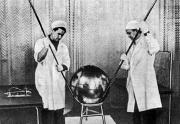 The launch was scheduled for October 7. But, as he told the cosmonaut G. M. Grechko, at a meeting with students "... we through their channels found out that the Americans are preparing to launch a satellite, reported it to the Korolev. It was a matter of prestige. Who's first? S. P. Korolev quickly made a decision: the preparatory work to cut, and start to appoint on the 4th of October."
The launch was scheduled for October 7. But, as he told the cosmonaut G. M. Grechko, at a meeting with students "... we through their channels found out that the Americans are preparing to launch a satellite, reported it to the Korolev. It was a matter of prestige. Who's first? S. P. Korolev quickly made a decision: the preparatory work to cut, and start to appoint on the 4th of October."
Early in the morning on 2 October 1957 the rocket was delivered to the launch site. S. P. Korolev was ahead of the installer along with all the main designers. Walked the entire one-mile path from the integration building to the launch pad. This path has been for many of them the road to immortality. So another tradition was born – to accompany the launch vehicle and spacecraft to the launch pad. On this day, the State Commission took a historic decision: to launch the first artificial Earth satellite on 4 October.
Starting day 4 Oct began in the morning and ended after midnight local time. October 4, 1957 in 22 hours 28 minutes 34 seconds Moscow time, a bright flash of light illuminated the night steppe of Baikonur rocket and with a terrible roar went up. Her torch was getting weaker and soon became invisible against the background of heavenly bodies. Royal rocket R-7 with the world's first artificial satellite of the Earth through 295,4 with, overcoming the force of gravity, the first cosmic speed of 7.78 km/s launched a satellite into orbit with an apogee of 947 km and a perigee of 228 km. Its famous Sputnik "beep... bleep... beep" announced to the world about the beginning of the space age.
So, after three centuries, was reached the first cosmic velocity calculated by the founder of classical physics and the law of universal gravitation Isaac Newton.
For the first time in history hundreds of millions of people could watch as the night sky moved the asterisk, created by human hands.
Many felt as though the satellite could be seen with the naked eye. This is not so. Driveline the moon's surface was too small for visual observation. In fact, all saw the second stage of the rocket, its Central block, which is left in the same orbit as the satellite.
During orbital flight was carried out to study the density of high atmospheric layers, we studied the propagation of radio waves in the ionosphere, as well as worked out the issues of monitoring of a space object from the Ground, transferred the information on pressure and temperature inside the satellite.
The preparations for the launch of the first artificial satellite to Baikonur was carried out by a 32-ha experimental test engineering part with the participation of industry representatives. Directly supervised the work of Colonel A. I. Nosov, Colonel Has.I. Ostashev, Colonel A. A. Vasiliev. It is noteworthy that in preparation for the launch of R-7 the first satellite was directly involved and officers-Kiev: P. Babenko, N. I. Barladin, V. A. Belikov, A. M. Voitenko, A. A. Davydenko, Y. P. Dejanov, A. P. Zavalishin, A. P. Creek, V. I. Kataev,.A. Kurashev, V. I., Leonenko, N. I. Mantulin, V. M. Mirov, V. V. Svishchev, F. D. Dodge, M. P. Fedorin, Y. A. Chupakhin, and many others.
Decree of the Presidium of the Supreme Soviet, 21 December 1957, many officers, sergeants, soldiers, workers and employees of the landfill was awarded high government awards.
Participant in the launch of the 1 St EAS General A. P. Zavalishin, recalled: "Everyone was shouting "Hurrah!" It was a great joy for the committed, for the sleepless nights test jitters, frantic pace of work was not in vain. But we haven't fully imagined what we did. Only when he heard the TARS report and began an unprecedented hype in the press, we realized that we did not just another start-up that have become commonplace, and the start of the landmark, which ushered in the space age of mankind."
The first satellite lasted 92 days and made 1440 turns around the Earth. It signals "beep ... bleep. .. bleep..."for 21 days agitated the minds of all earthlings. Its significance is a scientific / engineering achievement unmatched in human history. October 4, 1957 will forever go down in the history of the Earth!
A. S. Boltenko, honored test space technology, the Chairman of the Central Council of veterans of the Baikonur cosmodrome of Ukraine, head the Department of the history of aviation and cosmonautics of the DPM under KPI named after Igor Sikorsky.

